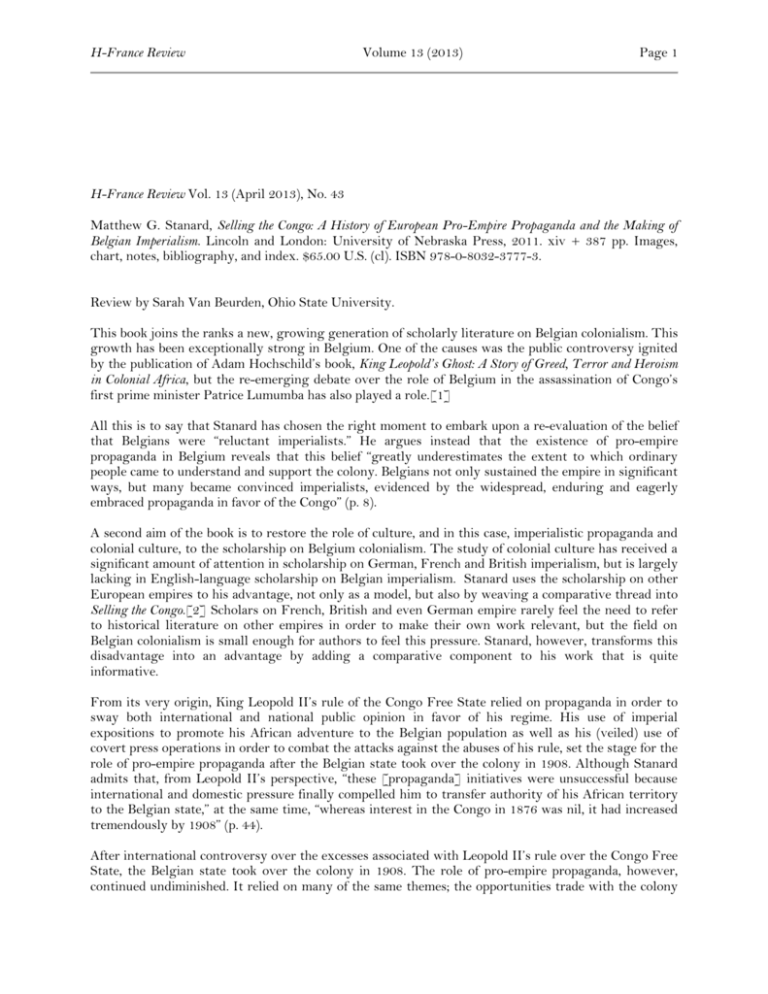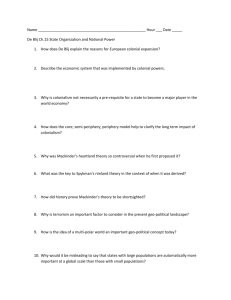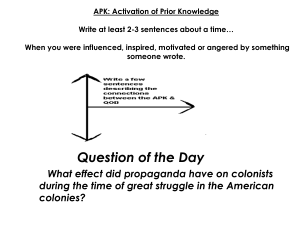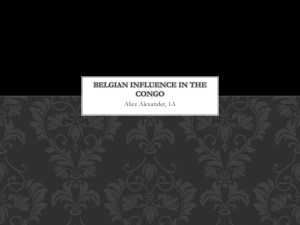
H-France Review
Volume 13 (2013)
Page 1
H-France Review Vol. 13 (April 2013), No. 43
Matthew G. Stanard, Selling the Congo: A History of European Pro-Empire Propaganda and the Making of
Belgian Imperialism. Lincoln and London: University of Nebraska Press, 2011. xiv + 387 pp. Images,
chart, notes, bibliography, and index. $65.00 U.S. (cl). ISBN 978-0-8032-3777-3.
Review by Sarah Van Beurden, Ohio State University.
This book joins the ranks a new, growing generation of scholarly literature on Belgian colonialism. This
growth has been exceptionally strong in Belgium. One of the causes was the public controversy ignited
by the publication of Adam Hochschild’s book, King Leopold’s Ghost: A Story of Greed, Terror and Heroism
in Colonial Africa, but the re-emerging debate over the role of Belgium in the assassination of Congo’s
first prime minister Patrice Lumumba has also played a role.[1]
All this is to say that Stanard has chosen the right moment to embark upon a re-evaluation of the belief
that Belgians were “reluctant imperialists.” He argues instead that the existence of pro-empire
propaganda in Belgium reveals that this belief “greatly underestimates the extent to which ordinary
people came to understand and support the colony. Belgians not only sustained the empire in significant
ways, but many became convinced imperialists, evidenced by the widespread, enduring and eagerly
embraced propaganda in favor of the Congo” (p. 8).
A second aim of the book is to restore the role of culture, and in this case, imperialistic propaganda and
colonial culture, to the scholarship on Belgium colonialism. The study of colonial culture has received a
significant amount of attention in scholarship on German, French and British imperialism, but is largely
lacking in English-language scholarship on Belgian imperialism. Stanard uses the scholarship on other
European empires to his advantage, not only as a model, but also by weaving a comparative thread into
Selling the Congo.[2] Scholars on French, British and even German empire rarely feel the need to refer
to historical literature on other empires in order to make their own work relevant, but the field on
Belgian colonialism is small enough for authors to feel this pressure. Stanard, however, transforms this
disadvantage into an advantage by adding a comparative component to his work that is quite
informative.
From its very origin, King Leopold II’s rule of the Congo Free State relied on propaganda in order to
sway both international and national public opinion in favor of his regime. His use of imperial
expositions to promote his African adventure to the Belgian population as well as his (veiled) use of
covert press operations in order to combat the attacks against the abuses of his rule, set the stage for the
role of pro-empire propaganda after the Belgian state took over the colony in 1908. Although Stanard
admits that, from Leopold II’s perspective, “these [propaganda] initiatives were unsuccessful because
international and domestic pressure finally compelled him to transfer authority of his African territory
to the Belgian state,” at the same time, “whereas interest in the Congo in 1876 was nil, it had increased
tremendously by 1908” (p. 44).
After international controversy over the excesses associated with Leopold II’s rule over the Congo Free
State, the Belgian state took over the colony in 1908. The role of pro-empire propaganda, however,
continued undiminished. It relied on many of the same themes; the opportunities trade with the colony
H-France Review
Volume 13 (2013)
Page 2
would create for Belgians and for the future of the Belgian economy, and the benefits civilization would
bring to the lives of Africans most prominent among them.
Stanard’s investigation of imperialistic propaganda follows five avenues: imperial expositions, colonial
museums, education and school materials, the construction of monuments, and film. Reflecting their
significance in other European empires, the occurrence of colonial exhibitions steadily increased during
the twentieth century, and private businesses and the church (both crucial pillars of Belgian colonialism)
participated in them. Probably the most important tool for the promotion of empire was the famed
Museum of the Belgian Congo in Tervuren, Belgium (today’s Royal Museum for Central Africa), which
displayed the colony’s natural history and resources alongside its cultural diversity. As a government
institution the museum struggled to balance a scientific mission with propaganda, an equation that only
started to tilt in the direction of science by the 1950s, Stanard writes. Detailing not only colonial
expositions at world and other fairs, he also adds a grassroots perspective to the discussion by including
the history of smaller quinzaines locales (colonial fortnights) and locally organized exhibits and museums,
which, he argues, “disclose a depth of support that raw attendance numbers at universal expositions
cannot reveal” (p. 87).
The most remarkable evolution in the content of pro-empire propaganda was the development of a
veritable “Leopoldian myth.” Stanard shows how colonial Belgian propaganda initially distanced the
government’s administration from Leopold II’s regime, but by the 1930s attempted to capitalize on the
king’s legacy instead. He locates the causes for this change in the Belgian state’s need to “bolster the
legitimacy of its colonial rule” with an imperial heritage (p. 59). There might, however, also be reasons
that had less to do with Belgian empire and more with internal politics. Belgium continued to be ruled
by the Von Saksen-Coburg dynasty, and aside from being a symbol for Belgian unity, the (unofficial)
influence of the royal family was something to be reckoned with, providing another reason for the
rehabilitation of one of its most important members. (Stanard brings this up in his conclusion, but the
argument is not pursued in any of the chapters.) The author’s comparative focus pays off in his
discussion of the content of pro-empire propaganda. He points out this focus on Leopold II is where
Belgian imperialistic propaganda differed from other European pro-empire propaganda, which did not
have any comparable figure.
In his chapter on education, Stanard addresses why the Belgian state wanted--and needed--its young
population to be educated about the colony. The answer lies with the state’s desire to populate its
administration in the Congo with Belgians (as opposed to citizens of other European countries who
were prevalent under Leopold II’s rule), but also in its need to create national faith in its colonial rule.
Compared to other empires, however, the coverage of Belgian colonialism was limited in Belgian
schoolbooks. It also took the country until 1923 to establish a colonial school.[3]
In order to remedy these shortcomings, the state-sponsored Commission Coloniale Scolaire brought proempire propaganda to the classroom. An important aspect is missing from this discussion on colonial
education, however. A significant part of Belgium’s primary and secondary school network consisted
(and consists) of Catholic schools. In these schools, Congo was often quite present because of the many
missionaries active in the colony. The main source of information and pro-empire propaganda in these
schools came from talks by visiting missionaries, school charitable actions for the missions, and Catholic
publications. Although this falls outside the scope of state-sponsored propaganda, its importance cannot
be underestimated when it comes to the knowledge many Belgians had of the colony.
The majority of memorials and monuments for Belgian empire and Belgian colonial pioneers, Stanard
reports, were built after 1908, with a particular boom in the interwar period. The themes of many of
these monuments, however, related to the (often invented) heroism and pioneering role of the Belgians
involved in the creation of Leopold II’s Congo Free State, underscoring the canonization of the “Leopold
II myth.” The majority of the monuments were the result of initiatives led by local colonial
H-France Review
Volume 13 (2013)
Page 3
organizations and inaugurations regularly drew crowds of people. Stanard cites both cases to support
his claim that the Belgian population was involved in propagating their country’s empire. He also notes,
however, that the monuments also served to unite a country in which national politics were heavily
inflected with Walloon-Flemish tensions.
The last chapter deals with filmmaking as a means of pro-empire propaganda. Early attempts at colonial
filmmaking in the late nineteenth century were fleeting, but picked up again in the aftermath of World
War I and flourished in the last decade of Belgian colonialism. Missionary films were an important part
of national film production after World War II, but since these were mostly aimed at a Congolese
audience, they remain largely outside Stanard’s scope. He does describe the ventures of colonial
companies such as the Union Minière du Haut-Katanga (UMHK) into the world of filmmaking in the
1950s and the apotheosis of colonial filmmaking for the 1958 Word Exposition in Brussels (commonly
referred to as Expo 58). The author focuses on those commissioning, funding and making the films more
so than on a close content analysis. This is understandable considering the scope of the book, but
hopefully future researchers will explore the content of the surviving films in more detail.
The Ministry of Colonies’s bankrolling of the colonial filmmaking industry, particularly in the 1950s,
points to a general trend in colonial propaganda. The state was always the prime sponsor of colonial
propaganda, but the renewed commitment of the Belgian state to its colonial identity from the postwar
era until the mid- to late 1950s required an intensified effort to convince the Belgian population of the
continued use and value of the colony.
The heavy government involvement seems to run counter to one of Stanard’s main points in this book,
namely the growth of pro-empire sentiment among the Belgian population and their participation in the
creation of imperialistic propaganda. The author himself admits that teasing out cause-and-effect is
tricky when it comes to propaganda. As a historical argument, however, equating the presence of
propaganda with pro-empire sentiment is problematic. It could potentially point to the opposite: a lack
of interest of the Belgian population in the colony and the government’s need to remedy this. Stanard’s
descriptions of the vigor of local colonial organizations, especially in the efforts to create local colonial
museums and monuments, are a good counterargument, but even those initiatives were often financially
supported by the government. Perhaps the argument could be more precise: what was the background
of those who became involved with the promotion of the empire? Were they from a particular class?
The decision to focus on expositions, museums, education, monuments and film has advantages and
disadvantages. They are, all five, very important avenues for imperialistic propaganda, but they are also
the ones about which the most has been written. Much of the work on these topics, however, was
published in Belgium, in either French or Flemish (Dutch). One of the great merits of this study is
Stanard’s incorporation of that scholarship and especially his use of Flemish language sources.[4] The
latter are often lacking in English-language publications on Congo, creating particular blind spots in
that literature.
Stanard’s choice of subjects also (naturally) shapes his conclusions. One of those concerns the lack of
female participation in the creation of pro-empire messages: “imperial propaganda was a male province,
both in terms of production and subject matter” (p. 255). Although this is true for the topics he discusses
(except for film, where one of the colonial filmmakers was a woman: Hélène Schirren), it might not be
true for imperial propaganda overall. A different focus--for example, on colonial women’s organizations
(such as the Union des Femmes Coloniales), local colonial charity organizations, or even on missionary
publications (given the large number of female congregations in Congo)--might paint a different picture.
The breadth of topics covered in this book is wide--each of them could fill a separate monograph. It is to
Stanard’s credit that he is able to pull them together. In terms of primary source work, I believe the
strength of the book lies in his discussions of the contributions of local organizations to the promotion
H-France Review
Volume 13 (2013)
Page 4
of Belgian imperialism. As a result of the scope of the book, however, the depth of the arguments
sometimes suffers. There is, for example, less systemic attention to the changes within Belgian
imperialism between 1908 and 1960 and how those affected the way in which the empire was promoted.
The breadth of this book, however, is also its strength. Although it might make it less appealing to
specialists in Belgian colonialism and Congolese history (with the exception of the sections on local
initiatives), it makes the book suitable for a broader audience interested in learning more about Africa
and empire. In addition, scholars of other European empires seeking to gain comparative knowledge will
find this book useful.
NOTES
[1] Adam Hochschild, King Leopold’s Ghost: A Story of Greed, Terror and Heroism in Colonial Africa
(Boston, Mass.: Houghton Mifflin Co, 2005 [1998]). For overviews of this new material and the debate
about the nature of Belgian colonialism, see Geert Castryck, “Whose History is History? Singularities
and Dualities of the Public Debate on Belgian Colonialism,” and Guy Vantemsche, “The Historiography
of Belgian Colonialism in the Congo,” in Csaba Lévai, ed., Europe and the Word In European
Historiography (Pisa: Pisa University Press, 2006), pp. 71-88 and pp. 89-119; and Idesbald Goddeeris and
Sindani E. Kiangu, “Congomania in Academia: Recent Research on the Belgian Colonial Past,” BMGN
Low Countries Historical Review 126/4(2011): 54-74.
[2] Referring to the work of John MacKenzie, Herman Lebovics, Catherine Hall, Robert Aldrich and
Lora Wildental, among others.
[3] Those interested in transatlantic history might be intrigued by a piece of information about the
Colonial School in Antwerp discovered by Stanard: the post-World War I American Commission for
Relief in Belgium helped defray the costs for the creation of that school (pp. 140, 305).
[4] Included is the work of, for example, Maarten Couttenier on the Museum of the Belgian Congo, Luc
Vints and Guide Convents on colonial cinema, Zana Aziza Etambala on Congo in the 1950s, and Guy
Vantemsche on political colonial history.
Sarah Van Beurden
Ohio State University
van-beurden.1@osu.edu
Copyright © 2013 by the Society for French Historical Studies, all rights reserved. The Society for
French Historical Studies permits the electronic distribution of individual reviews for nonprofit
educational purposes, provided that full and accurate credit is given to the author, the date of
publication, and the location of the review on the H-France website. The Society for French Historical
Studies reserves the right to withdraw the license for edistribution/republication of individual reviews
at any time and for any specific case. Neither bulk redistribution/republication in electronic form of
more than five percent of the contents of H-France Review nor re-publication of any amount in print
form will be permitted without permission. For any other proposed uses, contact the Editor-in-Chief of
H-France. The views posted on H-France Review are not necessarily the views of the Society for
French Historical Studies.
ISSN 1553-9172









